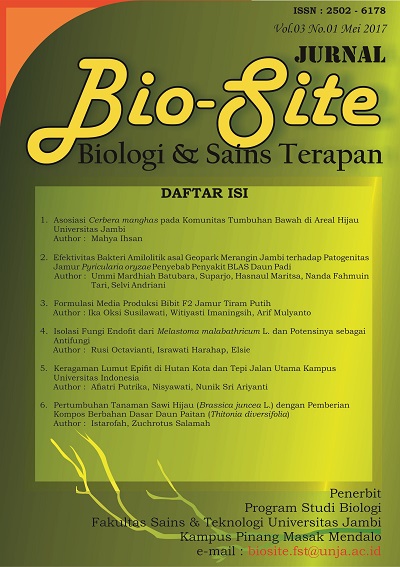Keragaman Lumut Epifit di Hutan Kota dan Tepi Jalan Utama Kampus Universitas Indonesia
Abstract
Research on epiphytic bryophytes has been conducted in two different sites located in Universitas Indonesia (UI). Those sites were urban forest and vegetation on main street margin of the campus. This study was carried out to compare diversity of the bryophyte at both sites. Twelve plots of 25 x 25 m2 were establish at the forest, while nine of 50 m line transect were made at the street margin. Five trees of each plot or line transect were sampled. Eight sub plots of 15 x 15 cm2 were placed on each trunk base (0--200 cm) of the tree sampels. The results obtained 23 species of epiphytic bryophytes, 21 species occured in the forest and 14 species were found at street margin. The similarity of bryophyte community between the forest and street margin were high (Sorenson similarity index = 0.73). Octoblepharum albidum was the dominant species at the forest, while Calymperes tenerum was dominant at the street margin. The diversity of epiphyte bryophyte at both sites were categorized low based on Shannon Wiener index (H’< 2), however they were not different significantly.
Downloads
Downloads
Published
Versions
- 2017-05-31 (1)
- 2017-05-31 (1)
How to Cite
Issue
Section
License
This work is licensed under a Creative Commons Attribution 4.0 International License.
Copyright Notice:
1. Authors retain copyright and grant the journal right of first publication with the work simultaneously licensed under a Creative Commons Attribution 4.0 International License that allows others to share the work with an acknowledgement of the work's authorship and initial publication in this journal.
2. Authors are able to enter into separate, additional contractual arrangements for the non-exclusive distribution of the journal's published version of the work (e.g., post it to an institutional repository or publish it in a book), with an acknowledgement of its initial publication in this journal.
3. Authors are permitted and encouraged to post their work online (e.g., in institutional repositories or on their website) prior to and during the submission process, as it can lead to productive exchanges, as well as earlier and greater citation of published work (The Effect of Open Access)







